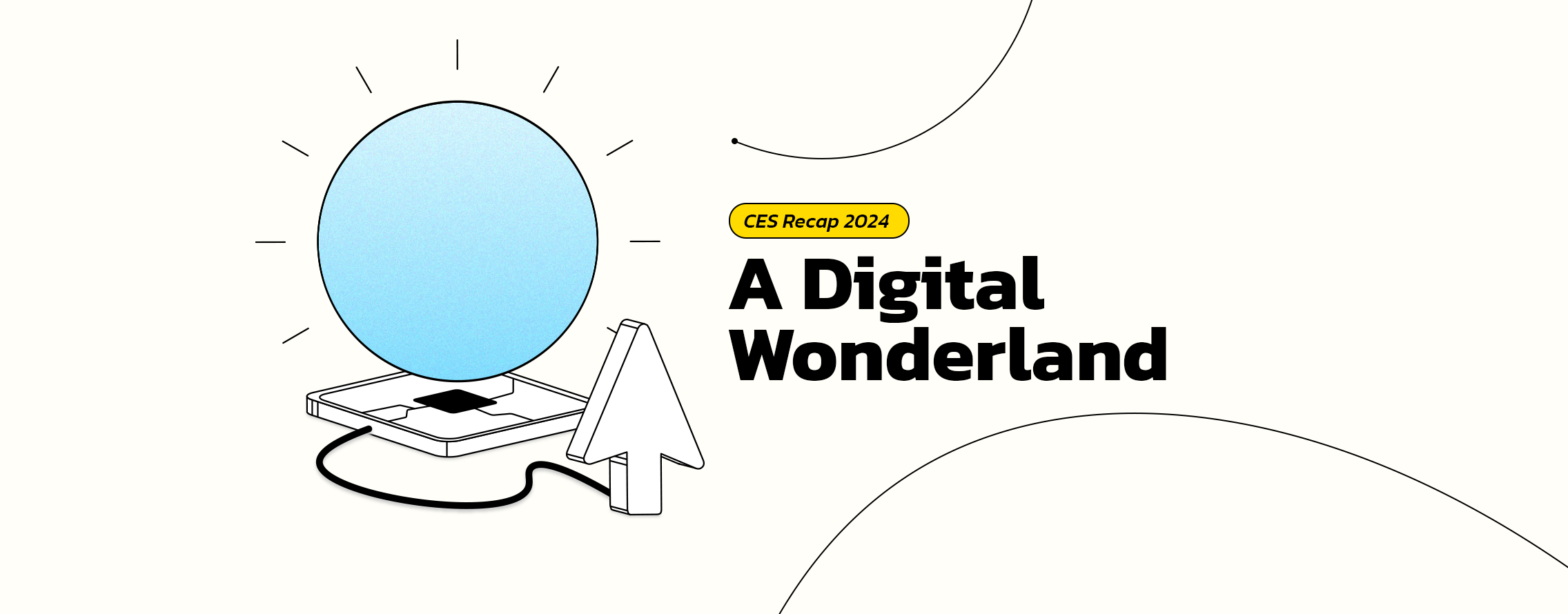CES 2024 Recap
The start of a new year brings many things – and one of them is the annual CES conference. Nearly 130,000 attendees descended on Las Vegas to experience the latest in consumer and enterprise technology from over 4,000 exhibitors. As we walked the floors of the conference center, AI was unsurprisingly omnipresent, yet our exploration revealed that the future tech landscape is anything but static.
From keynote speeches, to booth buzz and partner innovations in the advertising space, we’ve wrapped up the standout themes that we believe are set to make waves in 2024 beyond mainstream industry chatter.
A Digital Wonderland
Brainlabs’ take on the future of high-performance technology
Barely there tech
While there was no shortage of massive, impressive screens scattered throughout the conference, manufacturers are now looking for new points of differentiation beyond resolution and brightness. There was a focus on providing tech that is unobtrusive when not in use, products that blend into the background and complement home decor. Transparent screens not only unlock new solutions for showcasing 3D images, they fade into the background when turned off instead of being a “black mirror” taking up space on a wall. Smaller screens were showcased as natural looking wireless digital picture frames. Expect to see more of a focus on aesthetic beauty from tech manufacturers that enables people to reclaim their space and integrate art and screens into the home environment.
You’ll also see transparent product displays taking over the digital signage landscape, showing up in car dealerships, in tech stores, and store-front windows. While it looks transparent, or like art, it can provide additional information that merges the physical and digital worlds seamlessly!
VR immersion beyond the headset
For the past decade VR has been a major feature of CES tech, but this year we saw the longest lines for the solutions that paired VR goggles with other immersive tech. Gaming chairs built for racing and flight simulator experiences provided dedicated, built-in controls that enable the user to move beyond clicking a mouse or wiggling a joystick. Haptic feedback systems were on display in multiple booths, with gloves that aim to reduce the uncanny valley of VR by offering the physical sensation of touch – and we even saw haptic vests that deliver an even more immersive physical integration with virtual environments.
Imagine sensorialized in-game ad-opportunities where you can smell Febreeze-scented flowers to earn a gaming advantage and receive a product discount, or feel the heat as you walk through fire to earn game points and a product discount for Flaming Hot Cheetos.
Whole-home backup power
At least seven brands showcased breakthrough portable electric supplies that were strong enough to deliver an entire household’s energy needs, alongside automated switching systems that ensured instantaneous support in the event of a weather-related power failure.
These displays showed that in a post-covid-still-chaotic-political-and-economic-landscape, technology is proving to be our ally in preparing for the unforeseen.
We can’t help but wonder if management of the Las Vegas Convention Center were closely watching these solutions, especially after the 2018 CES power outage!
Everyone is prepping for the post-cookie future
Google ads were displayed on digital billboards throughout Las Vegas, and even took over the infamous Sphere. While they focused on touting the Android mobile OS, many attendees were focused on the undercurrent of worry about the massive change coming in 2024 as Google finally removes third party cookies from Chrome.
A wide variety of companies, from smart TV manufacturers like Samsung, to grocery chains like Albertsons, have been gathering consumer data and monetizing it via partnerships with other media providers – but as third-party cookies are depreciated and this data becomes more difficult to move between platforms, these companies have been focused on building out their own integrated advertising solutions based on their first-party data.
If you haven’t already, we suggest building a testing roadmap to see how these new solutions can help you reach your most valuable customers.
Continuing themes & effective AI
- Futuristic vehicles were scattered across the convention center, but only Honda seemed to have an actual plan to put these concept cars into production within the next two years.
- Many major exhibitors incorporated sustainability at the core of their showfloor presence, but from our perspective these often felt performative rather than truly transformational.
- Nostalgia played a big part. We saw retro designs for new products ranging from baby products, to projectors and boom box audio speakers, as well as retro products redesigned from the likes of Atari & Kodak.
- The device that got the most buzz was the Rabbit R1, a device that leverages AI to make carrying out tasks simple and intuitive. Its strength is that it implements artificial intelligence with a focus on outcomes – an excellent lens through which to qualify the myriad instances of AI overall.
Photo credit: AdAge
No longer an add-on, AI becomes entwined with consumer habits
Artificial intelligence was everywhere at CES – we even saw an AI-powered computer mouse (although how AI makes for a better mouse was, to put it gently, unclear). In the midst of all the noise and buzz, the best way to identify which AI solutions are truly transformative is to focus on the end user – the consumer.
As AI continues to impact consumers’ behaviours, savvy marketers are going to analyze what’s happening across their investment platforms to understand where to place the next dollar. There are three things that marketers should do to win:
-
01
Engage with your key platforms to understand their entire AI roadmap.
Not just for advertising-based AI, but also for consumer experience AI. Understand what they’re rolling out, what’s working and what’s not, and how effective it is.
-
02
Don’t take their word for it, and test for yourself.
Test early. Test often. One thing we’ve learnt over the past year is that AI experiences are going to evolve very quickly. A test that was run six months ago should be rerun if the platform in the solution has evolved significantly.
-
03
Make sure to bring ideas to partners.
No one knows your brand or customers like you do. Understand what your needs are to drive high-performance and take that feedback to the likes of Google, Amazon & Meta to make sure they know the objectives you’re working towards.
That’s a wrap!
As ever, the annual CES conference proved to be more than just a showcase of cutting-edge technology; it was a glimpse into the future that awaits us.
As the High-Performance media agency, Brainlabs is focused on delivering profitable business results for our clients, much like the Rabbit R1! Our Superteams create industry-leading predictive technology and work closely with media partners to ensure that we continually optimise the best solutions for brands.
Insights provided by
Jeremy Hull
Chief Product Officer NAMER
Brainlabs
Naomi Litowitz
SVP, Strategy & Planning NAMER
Brainlabs



